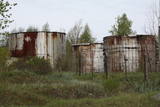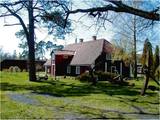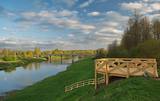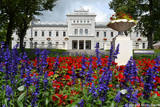| Нo | Название | Описание |
|---|---|---|
|
Rīgas - Daugavpils šosejas (A 6) 157. kilometrā skats jāpavērš Daugavas (rietumu) virzienā, kur cauri koku alejai klajā laukā 50 m attālumā no ceļa iegūlis Vaiķu akmens (7 m garš, 4,7 m plats un 1,7 m augsts). Akmens, kura tilpumu vērtē ~ 45 m³, pēc formas atgādina plakanu galdu. Nostāsti vēsta, ka to šeit atnesis velns. Kā jau šādiem akmeņiem „pienākas”, stāsta, ka te pusdienojis gan Krievijas cars Pēteris I, gan pats Napoleons. |
||
|
Кафе находится, в торговом центре «Сала» («Остров») в Екабпилсе, на правом берегу Даугавы. Уютное помещение кафе декорировано живыми цветами. Место, где можно позавтракать, пообедать или поужинать. Время работы: 9:00 – 20:00. |
||
|
Маршрут начинается в Риге с ее районом Югендстиля и Старым Городом. Затем отправляйтесь на поезде в Сигулду. Холмистая дорога ведет через Пещеру Гутмана, Турайдский Замок и Кримулдский Замок, которые стоят на берегах долины реки Гауя. Дорога затем идет в Лимбажи — типичный латвийский провинциальный город. Далее вы достигнете побережья Балтийского моря и Салацгриву, город, славящийся своими рыбацкими традициями и заколами для миног. За Салацгривой находятся редкие прибрежные луга и лагуны. После пересечения латвийско-эстонской границы, дорога вьется через старые прибрежные деревни — Икла, Треймани, Кабли и Хядеместе, прежде чем сливается с Виа Балтика. В Пярну прогуляйтесь по дороге для пешеходов Руутли и по старым укреплениям. А затем время переехать на острова — маршрут проходит через небольшой остров Муху. Посетите местное рыбное кафе в Ливи и этнографическую рыбацкую деревню Когува. Затем маршрут по дамбе ведет на остров Сааремаа. Основные достопримечательности во время маршрута - «Валъяла маалин» - один из наиболее впечатляющих холмовых фортов в Эстонии, церковь Валъяла и метеоритный кратер Каали. Оттуда на автобусе вы направитесь в столицу Эстонии Таллинн, с его очаровательным средневековым Старым Городом. А из Таллинна отправляйтесь на экскурсию на бывшую советскую базу для подводных лодок в Палдиски, незабываемом свидетельстве о недавнем историческом прошлом. |
||
|
Atrodas Numerenes dabas parka teritorijā. 20 m augstais tornis uzbūvēts uz t.s. Numerenes vaļņa, no kura paveras plaša ainava un aizaugošām lauksaimniecības zemēm un nelielu mitrāju ar Kugreņa ezeru austrumu virzienā. Torņa apkaimē izveidota izziņas taka. |
||
|
Выращивание и переработка чеснока, магазинчик деревенских продуктов. Рассказ о пользе чеснока для здоровья и о способах его применения в кулинарии. Предлагаются различные чесночные приправы, чаи, маринованные продукты, закуски, дегустация блюд с чесноком. Для детей ‒ рисование с помощью чеснока на ткани, игры с чесночной тематикой. |
||
|
Biškopības produkti bioloģiskajā saimniecībā, informācija par biškopību un dabas aizsardzību. |
||
|
Этот маршрут позволит Вам увидеть самые впечатляющие средневековые замки Латвии или их руины, равно как и знаменитые особняки в аристократических поместьях, датируемые 18 и 19 веками. Особняк поместья Унгурмуйжа – единственный из уцелевших в Латвии деревянных дворцов из тех, что были построены в начале 18 века. Развалины Цесиского замка – в числе наиболее впечатляющих средневековых развалин в стране. Башня Турайдского замка предлагает панорамный вид на старинную долину реки Гауя. Около половины маршрута проходит через Национальный парк Гауя. Вы прибудете в место существования самой старинной переправы на балтийских реках – плоты, которые перевозят людей через реку, до сих пор приводятся в движение течением. В качестве мест для ночлега выбраны баронские поместья и замки, где это возможно. Вас будут кормить в ресторанах высшего класса или в местах, где Вы сможете попробовать традиционную латышскую еду и насладиться местной атмосферой. |
||
|
Предлагают размещенный в выработанном карьере пляж с площадкой для отдыха. Две волейбольные площадки, качели, батуты, надувные аттракционы. К радости для самых маленьких имеется «лягушатник». В отдельном карьере предлагается рыбалка - форель, карп, палия, сом. Здесь же на месте можно и приготовить рыбу – поджарить, сварить уху. Для приготовления рыбы предлагаем все необходимое. Рыбалка - круглый год. |
||
|
Находится в исторической части Павилосты около серых дюн. В строительстве спроектированного в современном стиле здания использован кирпич Лиепайского Военного порта. Широкие окна, летняя терраса. Сотрудничает с надомниками. Латышская кухня: Маринованная селедка, приготовленная на костре уха, холодный суп, овощной суп, жареная камбала и треска, копченые окуни и вимба, тонкие блинчики. Особое блюдо: Жареный палтус. |
||
|
Atrodas Rīgas ielā 8 – skaistā, 1883. g. celtā jūgendstila ēkā . Muzejs (viens no Latgales lielākajiem un vecākajiem) tajā darbojas no 1959. g. (pats muzejs dibināts 1938. g.) un tā krājums vēsta par Daugavpils un tās apkārtnes vēsturiskajiem notikumiem. Tajā regulāri tiek rīkotas arī tematiskās izstādes, piedāvātas muzejpedagoģiskas programmas. Te vēl var apskatīt Daugavpilī dzimušā un pasaulē pazīstamā mākslinieka Marka Rotko (1903. – 1970.) gleznu reprodukcijas, kuras no 2013. gada plānots pārcelt uz M. Rotko centru Daugavpils cietoksnī. |
||
|
Гауя — это самая красивая река в Латвии, с впечатляющей речной долиной, доходящей в глубине до 80 метров. Живописные обнажения пород песчаника возвышаются над рекой. Гауя — это спокойная река, с всего лишь несколькими маленькими порогами. Катание на лодке для отдыха здесь замечательно. Между Цесисом и Сигулдой, Гауя течет через Национальный парк Гауя. На берегах реки находятся несколько хорошо оборудованных причалов для лодочников, со скамейками, столами, местами для костров, хворостом и информационными стендами. На пути встретятся несколько достопримечательностей культурного наследия — старомодный паром Лигатне, средневековый замок Турайда и поместье Кримулда. |
||
|
В настоящее время территория ракетной транспортной части военного порта не используется, относительно огорожена и частично закрыта.
|
||
|
Музей (ул. К. Валдемара 47) был открыт в 1969-м году в старом здании мореходной школы, которая была основана в 1864-м году по инициативе К. Валдемара. За время существования мореходной школы здесь получили образование более 1000 капитанов и штурманов дальнего плавания. Экспозиция музея знакомит с деятельностью первой латышской мореходной школы, а также с историей строительства парусников на Видземском побережье во второй половине 19-го века и начале 20-го столетия. В саду музея можно осмотреть коллекцию якорей и верхнюю часть (отреставрированная) смытого в свое время Айнажского маяка. |
||
|
Крестьянское хозяйство «Пиладжи» находится в Дурбском крае, Дурбской волости. Основной вид деятельности хозяйства – выращивание зерновых. Дополнительно в хозяйстве занимаются разведением крупного рогатого скота, выращиванием рассады цветов и овощей. |
||
|
Находится на левом берегу реки Вента, в 100 метрах на северо-запад от моста через Венту на Лиепайском шоссе (А 9). Городище предков, на котором с 14-го по 18-й век находился орденский замок (разрушен во время Северной войны). До наших дней от него ничего не сохранилось. На городище расположена эстрада, построенная в 1987-м году – популярное место проведения мероприятий. Эстраду окружает парк с деревянными тронами первых куршских королей, изготовленными скульптором Г. Бурвисом. О городище сложены предания – о подземных ходах, о белой женщине, которая появляется раз в сто лет. |
||
|
Плунге славится парком князей Огинских. Парк смешанного типа был разбит на месте жемайтийской священной рощи в XVIII–XIX вв. Гордостью парка являются один из древнейших и крупнейших в Литве дубов, получивший имя языческого бога Перкунаса (Перуна), легендарная Плачущая липа и Пятиствольный ясень. По указанию князя Огинского здесь было вырыто семь каскадных прудов, соединенных каменными мостами-шлюзами. Уникальную живописность парку придает протекающая по нему река Бабрунгас. |
||
|
Atrodas ceļa, kas ved uz Miķeļtorņa bāku – līkuma malā. Unikālā ēka (vienīgais lībiešu ciemu krogs ar raksturīgo plānojumu, kas saglabājies līdz mūsdienām) šobrīd atrodas avārijas stāvoklī un apskatāma tikai no ārpuses. Pizes krogs celts 1853. gadā. |
||
|
Alūksnes novada saimniecībā "Pauguri" kokamatnieks Jānis Vīksne izgatavo koka virpojumus - cibiņas, pulksteņus, pildspalvas, spēles, šūpoles un citas saimniecībā noderīgas lietas. Iespējams iegādāties kokamatniecības suvenīrus - dekoratīvus un praktiskus virpojumus no koka. Senlietu muzeja apskate - seni galdniecības darba galdi, ēveles, āmuri, sirpji, grābekļi, sējmašīna, pulksteņi, trauki u.c. Saimniecībā ir izveidota skatu platforma, no kuras paveras skats uz Hānjas augstienes ainavām Igaunijā, kā arī atpūtas vieta vasaras piknikam ar galdu, uguskura vietu un skulptūrām. |
||
|
Saimniecības zemi, kas atrodas starp Ulbroku un Vālodzēm, 1929. gadā nopirka tagadējā saimnieka – Dzintara Āboliņa vectēvs. Tajā laikā arī tika uzcelta klēts, kurā glabāja saimniecībā izaudzēto lauksaimniecības produkciju. Krīvu klēts atdzimšana notika pirms 20 gadiem, kad tagadējie saimnieki tajā uzsāka veidot muzeju no sadzīves priekšmetiem un darba instrumentiem, kas savulaik izmantoti Krīvu saimniecībā. |
||
|
Институт садоводства является ведущим исследовательским центром плодоводства и овощеводства в Латвии, который занимается не только селекцией и внедрением сортов растений, подходящих для агроклиматических условий Прибалтики, но и производит из выращенного в садах института богатые клетчаткой продукты питания с высокой пищевой ценностью. Во время весеннего цветения гости Добеле могут прогуляться по одному из крупнейших сиреневых садов в Европе, в котором растут 240 различных сортов сирени. В мае / июне гости сада Института садоводства могут насладиться пышным цветением абрикосов, вишни, слив, яблонь, груш и айвы. |
||


























